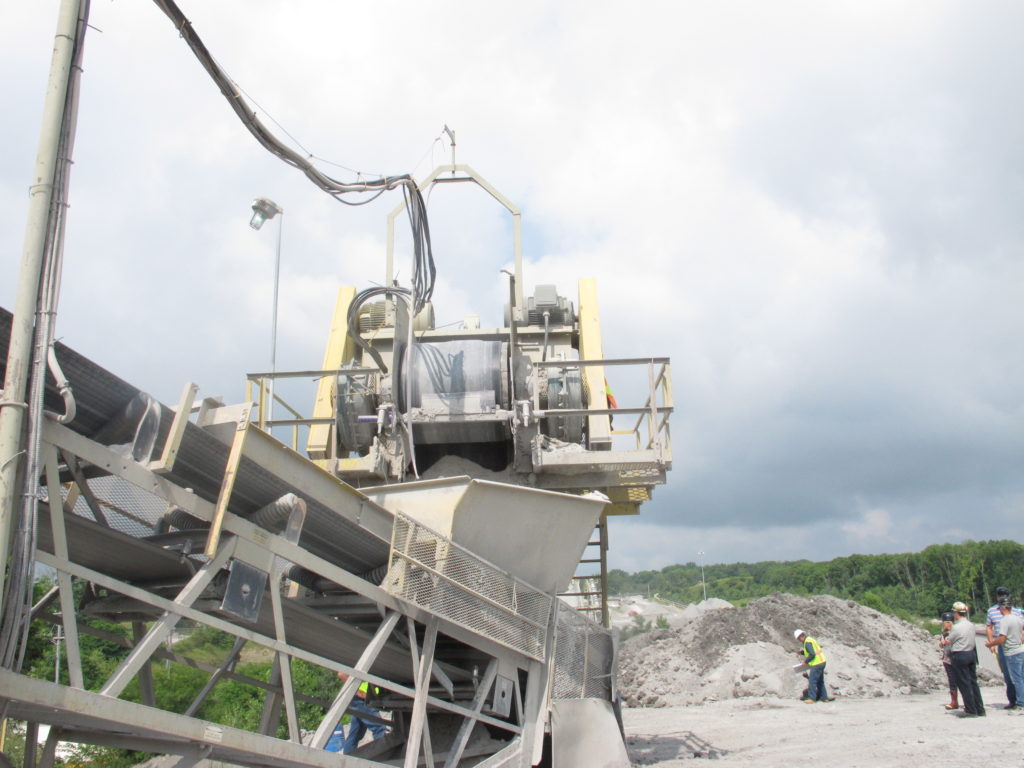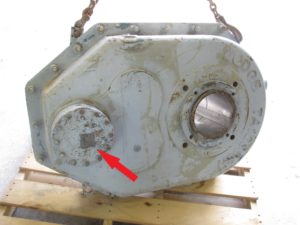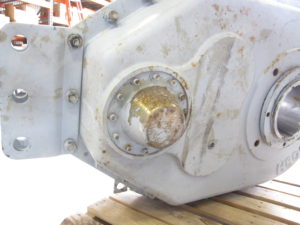This is the second in a two-part blog series about conveying equipment that severely injured a worker at a mine. In case you missed it, click here to read Part 1 where I describe the incident and the mining equipment. In this part, I will discuss my engineering analysis of the incident and the machinery involved and share the conclusions I reached.
The injured miner was a front-end loader operator. He was not a maintenance worker. He simply responded to a radio request for help with the conveyor. Power to the electric conveyor motors was locked out, but none of the maintenance workers did anything to lock out or block the hazardous gravitational potential energy in the heavy load of stone on the belt.
Figure 1: A view of the head pulley showing the north and south side speed reducers. Only the north side speed reducer had a backstop. When the north side torque arm was disconnected, there was nothing to stop the belt and its load from running downhill due to gravity. The moving belt caused the partially disconnected north side speed reducer to unexpectedly rotate and repeatedly strike a miner.
Figure 2: A composite view of two speed reducers. The speed reducer on the left has a backstop as indicated by the red arrow. The speed reducer on the right has no backstop.
The mine relied on an outside company to properly design and install all components of the hill conveyor including the motors, speed reducers and the backstop function. The mine agreed that the backstop on the hill conveyor is a safety device but did not understand its importance. If the outside conveyor design company had recommended two backstops for the hill conveyor, one for each side, the mine would have purchased two backstops. The conveyor design company did not warn or instruct anyone at the mine that the hill conveyor and the north side gear reducer would move suddenly and unexpectedly if the turnbuckle on the north side was removed. The conveyor company did not train, warn or instruct anyone at the mine about how to prevent the conveyor from rolling backwards. The conveyor company did not warn or provide instruction that there was only one backstop on the hill conveyor drive. The conveyor company also confirmed that the backstop is a safety device to prevent backward rotation of the conveyor belt. The conveyor company agreed that two backstops on the hill conveyor would have made the hill conveyor safer.
The conveyor company agreed that it was technologically and economically feasible to add another backstop. The conveyor company agreed that the hill conveyor would not have released if there was a functional backstop on the other side of the hill conveyor. The cost of an additional backstop was negligible in comparison to the total cost of the conveyor company’s work.
As a result of my investigation of the incident, I concluded that:
- The hazard that injured the miner is a hill conveyor with two motors, two speed reducers and two turnbuckles but with only one backstop located on the north side speed reducer and no backstop on the south side speed reducer. When the turnbuckle on the south side is removed, the belt will not move because the north side backstop prevents the north side speed reducer from turning in reverse. If the turnbuckle on the north side is removed, the north side backstop becomes ineffective, and the south side gear reducer has nothing to prevent it from turning backward. As a result, the belt and its load run downhill, and the north side speed reducer rotates hazardously about the head pulley shaft.
- The single backstop on the hill conveyor with two motors and two speed reducers does not adequately control the hazard of unexpected movement of the belt, load, and machinery. The turnbuckle on the south side of the head pulley can be loosened or removed safely but removing the turnbuckle on the north side will produce disastrous consequences.
- It was technologically and economically feasible for the outside conveyor company to adequately control the hazard of unexpected movement by installing a backstop on each of the two speed reducers so that either turnbuckle could be disconnected without the conveyor moving due to gravity.
- It was or should have been foreseeable to the outside conveyor company that the hill conveyor would need to be serviced while the belt was loaded. The outside conveyor company could have and should have provided an adequate protective device to prevent the hill conveyor and speed reducers from moving during servicing operations.
- The hill conveyor is defective because:
- It contains an inadequately controlled hazard of unexpected movement due to gravity.
- There is a high and foreseeable risk of severe injury from uncontrolled movement of large, heavy power transmission components including the speed reducer and its turnbuckle.
- There is a high probability of occurrence of harm any time the large, heavy, uncontrolled rotating components strike a worker.
- It was technologically and economically feasible for the outside conveyor company to install a second backstop on the south side speed reducer that would have prevented the hill conveyor, north side speed reducer and turnbuckle from moving unexpectedly.
- The risks associated with the hill conveyor outweighed its benefit.
- Adequate warning or instruction was not provided.
- The defective condition of the hill conveyor was a cause of the miner’s injury.
If you have a case involving an injury caused by conveying equipment, please give us a call. We at The Warren Group would be happy to help you determine the cause of the incident.
Jeffery H. Warren, PhD, PE, CSP, is the chief engineer and CEO at Warren specializing in mechanical, machine design and safety. His deep expertise in machine design and safety analysis makes him a frequent presenter, trainer and expert witness. In addition to investigating more than 2000 claims involving property damage and injuries related to machinery and equipment since 1987, Jeff has an undergraduate degree in Mechanical Engineering from UNC Charlotte as well as a Master of Science and a Doctorate in Mechanical Engineering from Virginia Polytechnic Institute and State University — both with machine design emphasis.






